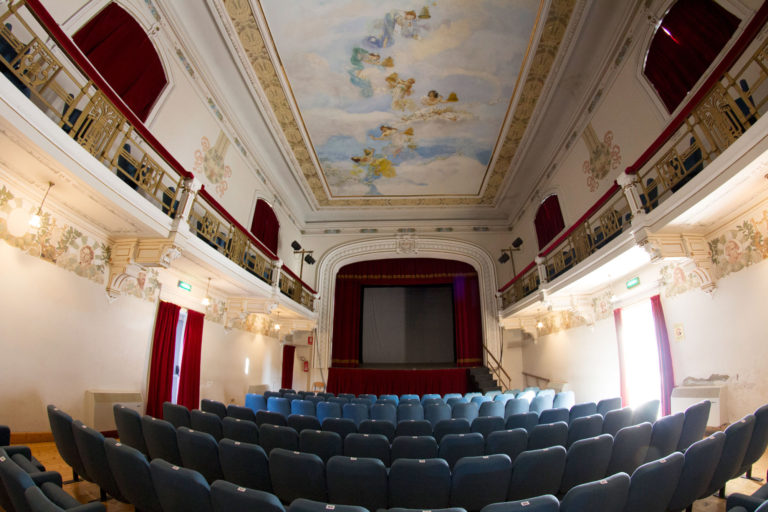The Bruscello Theater

The Bruscello is a form of traditional folk theater, born in Tuscany and rooted in the Valdichiana area. Its origins lie in the ancient rural rites and in the folk tradition of celebrating the end of winter. The theatrical representation was sung in octuplets, usually accompanied by simple musical motifs. It was usually staged inside the big farmhouses of the sharecropping countryside, planting a ‘bruscello’ (from arboscello, meaning a small tree) which was then used as centerpiece of the set. The Bruscello is a folk tradition as it deals with subjects known mainly among the peasants. It is also made by peasants: they are, at the same time, the actors and the audience.
In Montepulciano, in addition to the Bruscello, there were also two other ritual traditions called “Sega la Vecchia” (saw off the old lady) and the “Maggio” (May) which then became part of the folk theater. The Bruscello is a sung folk play that takes place in Piazza Grande, Montepulciano, since 1939, usually around august 15th. The first author of the Bruscello Poliziano was Marcello del Balio, parish priest of the town who also revived the tradition of the Bravìo delle Botti. To celebrate his memory, the garden surrounding the Fortress of Montepulciano has been named after him.
 The typical subjects of the Bruscello Poliziano are, for example, the tales of the Royals of France (Fioravanti, Rizieri the Paladin, Guerrin the mean), the myths of Orpheus and Eurydice and Tristan and Iseult or the stories of popular literary characters such as Calandrino by Boccaccio, Romeo and Juliet by Shakespeare or Dante’s Divine Comedy: Pia de’ Tolomei, Paolo and Francesca and Count Ugolino. In fact, despite the high rate of illiteracy, many peasants could still recite big portions of the Divine Comedy by heart. The Bruscello has also told the tales of some important local characters like the etruscan king Lars Porsena, Zelindo the Garibaldino, Del Pecora, Ghino di Tacco, St. Catherine of Siena and St. Mustiola.
The typical subjects of the Bruscello Poliziano are, for example, the tales of the Royals of France (Fioravanti, Rizieri the Paladin, Guerrin the mean), the myths of Orpheus and Eurydice and Tristan and Iseult or the stories of popular literary characters such as Calandrino by Boccaccio, Romeo and Juliet by Shakespeare or Dante’s Divine Comedy: Pia de’ Tolomei, Paolo and Francesca and Count Ugolino. In fact, despite the high rate of illiteracy, many peasants could still recite big portions of the Divine Comedy by heart. The Bruscello has also told the tales of some important local characters like the etruscan king Lars Porsena, Zelindo the Garibaldino, Del Pecora, Ghino di Tacco, St. Catherine of Siena and St. Mustiola.
The Bruscello Poliziano is quite unique if compared to other Bruscellos sung in the same geographical area, as it goes back to ancient times. Documents report that, in the 20’s, peasants would form a Company to sing the Bruscello in the local theaters. The real transformation happened in 1939 due to an intervention of the theatrical vanguard. Before then, the story was always told as a synopsis, with the actors singing the same ditty in octuplets: this made the narration seem rather random and slow, as to express a single concept it would take an entire hendecasyllables octuplet. All the roles were played by men, even the female parts. The Bruscello was originally itinerant: it would be staged in markets, during religious events and festivals. But in 1939 it moved to the parvis of the Cathedral of Montepulciano: a wide stage before a square that could host up to two thousand spectators. No more accordion to accompany the singers, but the Orchestra of the Music Institute. And then lights worthy of a big theater, costumes tailor-made for the first time and professional props. Even the repetitive sung parts were replaced with more paced compositions.
Every character of the Bruscello is characterized by their own ditty and metric, usually quatrains to enhance the rhythm and intensity of the action. The set, once simple or absent, now usually consists of an accessible wooden castle. The story is partitioned in three acts comprising three scenes each. At the beginning of each act, the historian sings a traditional octuplet and explains what the act will be about, while a storyteller explains the single scenes and greets the audience at the beginning and at the end of the show. The Bruscello Poliziano was born as a simple play, but today it has turned into a real, complete theater piece.
More informations at: www.bruscello.it
(photo by Alessandro Gaziano – video by Alex Marchi)




